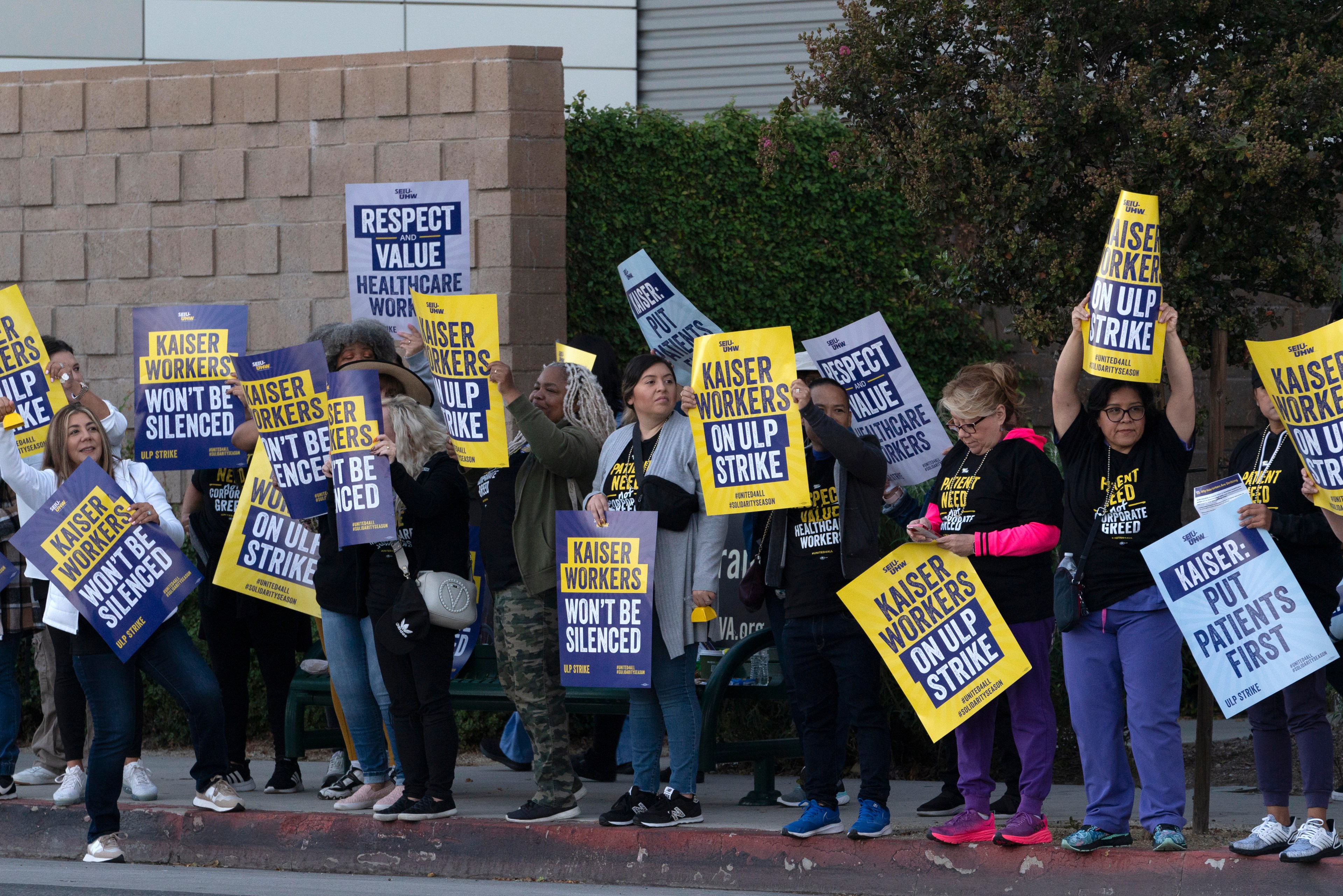More than 75,000 Kaiser Permanente employees returned to work this weekend after staging what’s being called the biggest health care strike in the nation’s history.
The walkout lasted from Wednesday to Saturday, included 60,000 Kaiser employees in California—20,000 of them in the Bay Area—and had a direct impact on patients by delaying appointments and shuttering clinics.
Now, the union alliance that led the labor action is bracing for a longer work stoppage if the next round of negotiations fails to culminate in a new contract.
The Coalition of Kaiser Permanente Unions plans to resume talks with the Oakland-headquartered nonprofit hospital chain on Thursday and Friday. But the eight-union bloc issued a statement saying it was winding down its three-day strike while setting the stage for a 10-day walkout “if Kaiser executives continue to commit unfair labor practices and bargain in bad faith.”
Outsourcing and understaffing have emerged as sticking points for labor organizers, who say they want higher pay to stem a staffing exodus fueled by pandemic burnout.
“Frontline healthcare workers continue to await meaningful action by Kaiser executives to address our key priorities, including safe staffing, outsourcing protections for incumbent healthcare workers, and fair wages to reduce turnover,” Gwendolyn Holloway, a contact lens technician at the Kaiser Permanente Vallejo Medical Center, said in a union news release Friday.
About midway through the few-day walkout, Kaiser said on its website that the company reached “a number of tentative agreements in bargaining” over the six months of negotiations before the union contract expired on Sept. 30.
Namely, Kaiser officials wrote, the company offered:
- Across-the-board wage increases in all markets over the next four years.
- Minimum payouts and potential for up to a $3,750 payout per employee.
- Base hourly wages of $25 in California and $23 in other states.
- More generous health benefits and retirement income plans.
- Renewed tuition and training as well as more funding for education trusts.
Kaiser said it also met its goal of hiring 10,000 union-represented workers—something it planned to do before the year’s end but had already completed by the time the strike commenced on Wednesday. That brings the number of new hires to 50,000 over the past two years, the company said.
Company officials noted that Kaiser is hardly alone in grappling with the issues brought to the fore by the union coalition.
“Together, we have faced the toughest challenges over the past three years,” Kaiser officials said. “Kaiser Permanente, our industry, and our employees are now operating in a new cultural, labor, and post-pandemic environment that we are all working hard to understand. We are committed to finding workable solutions for this new environment that meet our responsibility to balance taking care of our employees and being affordable to our members.”
The Kaiser walkout comes during one of the nation’s biggest years for strikes in the past two decades. According to Bloomberg Law’s database of work stoppages, more than 445,000 workers have walked off the jobs this year in a slew of industries.
In Hollywood, 160,000 actors went on strike to demand higher wages and job protections amid increasing reliance on artificial intelligence. Elsewhere in the country, some 25,000 autoworkers took to the picket lines against the Big Three: Ford, General Motors, Stellantis.
While picketing in entertainment, manufacturing and other industries can drag on for months, however, health care strikes typically span just a few days because of their impact on critical services.
The broader and deeper repercussions of the Kaiser strike have drawn the attention of President Biden’s Acting Labor Secretary Julie Su, who flew to California this week to talk to both sides in the contract negotiations.
The U.S. Department of Labor confirmed in an email to The Standard that Su plans to jump back into the fray when bargaining resumes in the coming days “to assist the parties in advancing talks towards a fair contract for this critical workforce.”
“As the president and the acting secretary have said, collective bargaining works, even when it takes time,” a Department of Labor spokesperson wrote. “We are glad to see the parties going back to the bargaining table.”
Among the tens of thousands of Kaiser employees who joined the labor action this week were vocational nurses, emergency staff, radiology and X-ray techs, ultrasound sonographers, telehealth reps, respiratory therapists, behavioral health workers, pharmacists, phlebotomists and home health aides.
Though managers, doctors and nurses haven’t been involved in the strike, the scale of the walkout forced Kaiser to close clinics and pharmacies and prompted a flurry of rescheduling for non-urgent procedures.
Kaiser’s website says the chain serves nearly 13 million customers—9 million of them in California—and runs 39 hospitals and 622 medical offices in several states. Company officials urge its members to check kp.org for the latest updates.
